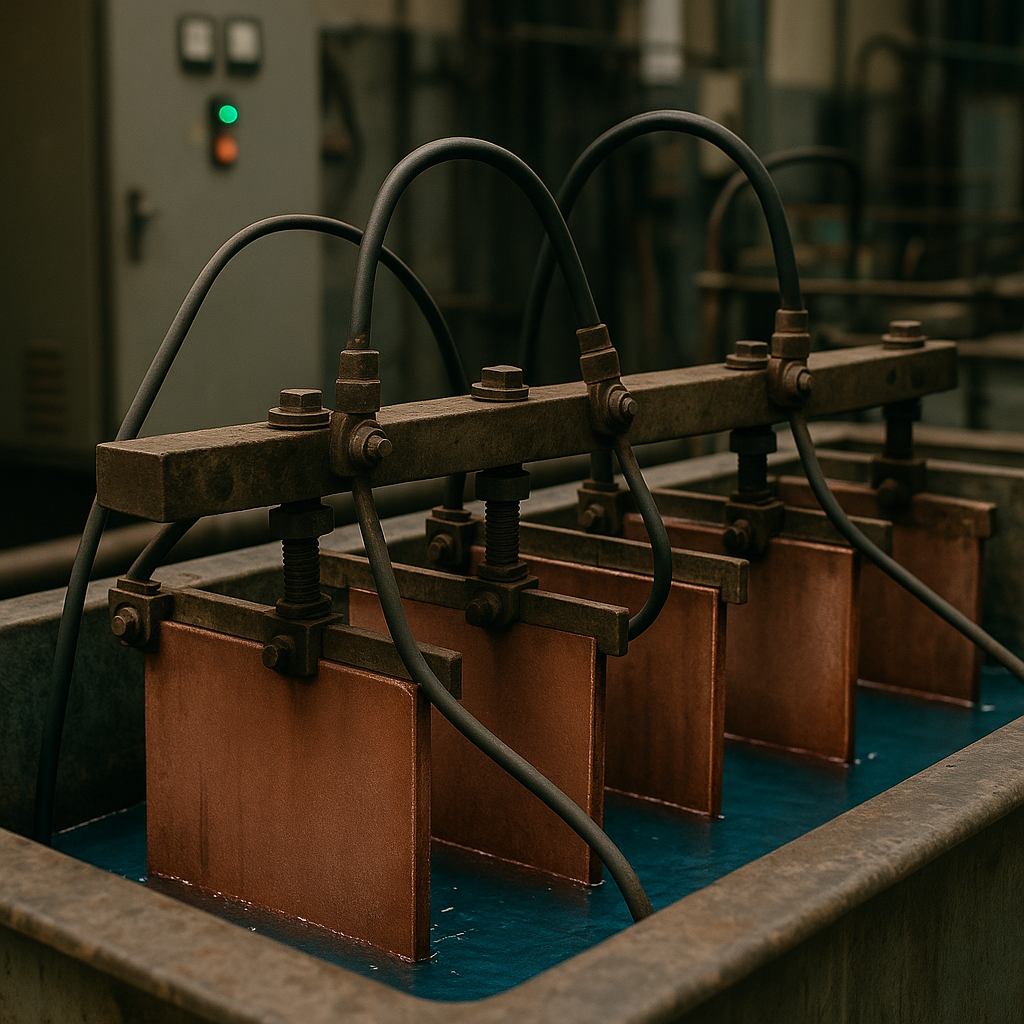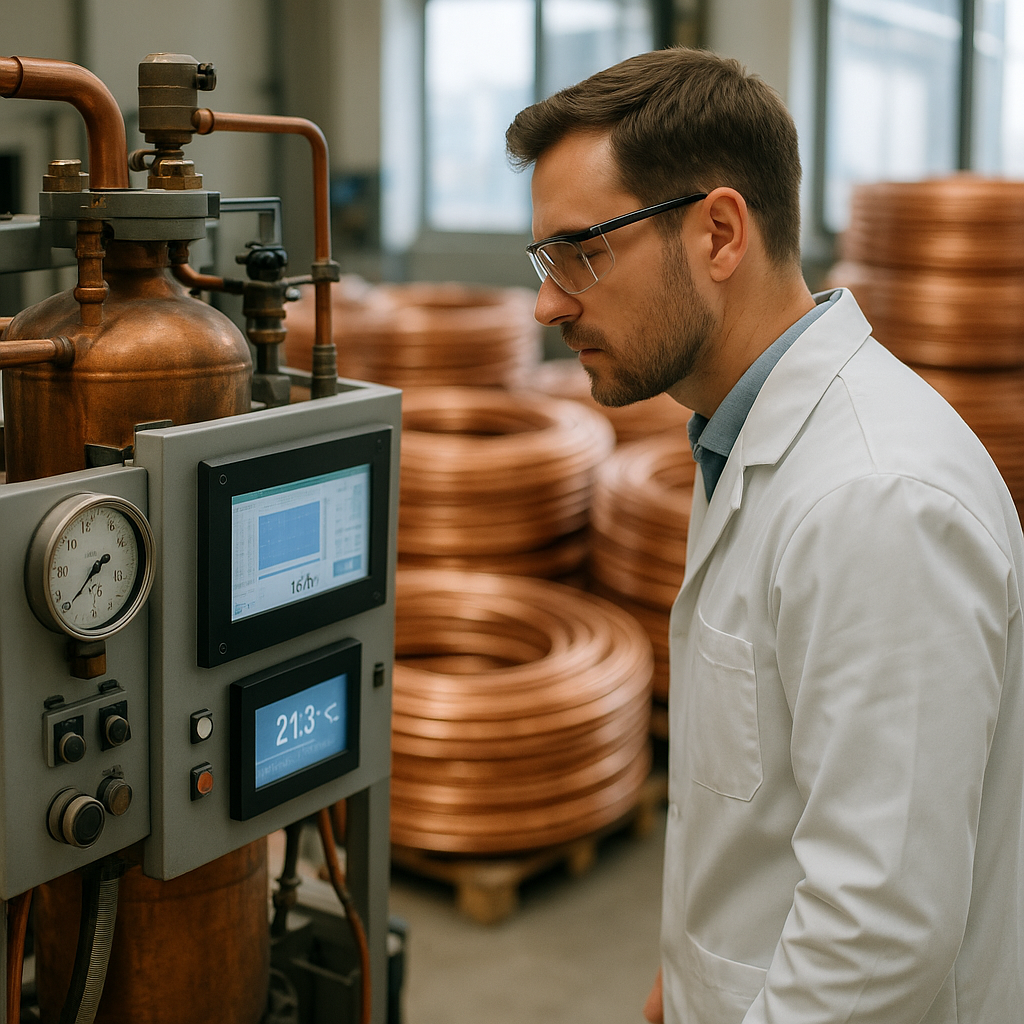5901 Botham Jean Blvd, Dallas, TX 75215
Electrolytic Refining of Scrap Copper: Process, Benefits, and Industrial Applications
October 10, 2025Electrolytic refining transforms impure scrap copper into high-purity metal through a complex yet straightforward electrochemical process. This method uses electricity to dissolve copper from an impure source and selectively deposit it as pure copper elsewhere. The resulting metal achieves purity levels of up to 99.99%, making it essential for electrical applications where conductivity is crucial.
The process involves placing impure copper as an anode in an electrolyte bath containing copper sulfate and sulfuric acid. When an electric current flows through this setup, copper atoms from the anode dissolve into the solution as copper ions. These ions then travel through the electrolyte and deposit onto a cathode made of pure copper or stainless steel. The method is highly selective; impurities either remain at the anode as a sludge or stay dissolved in the solution.
As global demand for ultra-pure copper continues to rise due to increased reliance on electronics and renewable energy technologies, electrolytic refining remains the standard for copper purification. It bridges the gap between recycled scrap metal and the pristine copper needed for everything from household wiring to advanced electronics. This process showcases how modern recycling technologies can transform waste materials into valuable resources with properties matching those of virgin materials.
How Does the Electrolytic Refining Process Work?

The electrolytic refining process is a precise electrochemical method used to produce high-purity copper from impure copper scrap. This sophisticated procedure separates copper from various impurities through a controlled flow of electricity.
The Basic Setup
The process operates within an electrolytic cell containing an acidic copper sulfate solution serving as the electrolyte. Key components include an anode made of impure copper and a cathode consisting of a thin sheet of high-purity copper. These electrodes are immersed in the solution and connected to a direct current power source. The current flows from the power source through the anode, into the electrolyte, and then to the cathode before returning to the power source.
The Chemical Reactions
When electric current passes through the cell, a fascinating series of reactions occurs. At the anode, copper atoms lose electrons and dissolve into the electrolyte as copper ions. This oxidation reaction can be written as:
Cu (solid) → Cu²⁺ (aqueous) + 2e⁻
The copper ions travel through the electrolyte to the cathode. At the cathode surface, these ions gain electrons and deposit as pure metallic copper. This reduction reaction is:
Cu²⁺ (aqueous) + 2e⁻ → Cu (solid)
The net result is copper transferring from the impure anode to the pure cathode while leaving impurities behind.
Handling of Impurities
The process manages impurities in two ways. Metals less reactive than copper, such as gold, silver, and platinum, don’t dissolve at the anode. They form what refiners call “anode slime” that collects at the bottom of the cell. This valuable byproduct is later processed to recover these precious metals.
Metals more reactive than copper, such as iron, zinc, and nickel, dissolve into the electrolyte alongside copper. However, these impurities remain in solution rather than depositing on the cathode. The copper sulfate solution acts as a selective filter that allows only copper to plate out while other metal ions stay behind.
Industrial Application
Modern industrial electrolytic refineries operate multiple cells connected in series to form practical sections. They maintain precise control over current density, temperature, and electrolyte composition, with cell voltage typically around 0.25-0.30 volts. The process achieves remarkable purity levels. While the starting anode material might be 99.0-99.6% copper, the resulting cathode copper often exceeds 99.95% purity, which is essential for applications requiring excellent electrical conductivity. After a predetermined period, the cathodes are removed, washed, and prepared for shipment. The depleted anodes are recycled back into the process.
Through this carefully controlled process, electrolytic refining transforms impure copper into exceptionally pure metal, powering modern electrical infrastructure. The method’s elegance lies in its simplicity and effectiveness, using electricity to purify electricity’s most important conductor.
What Are the Benefits of Electrolytic Refining for Scrap Copper?
Electrolytic refining is considered the gold standard for processing scrap copper, offering substantial advantages that make it invaluable in the recycling industry. This method delivers results other refining approaches cannot match.
Unmatched Purity Levels
The most compelling benefit of electrolytic refining is its ability to produce ultra-high-purity copper, achieving levels up to 99.99%. This far exceeds traditional fire refining methods, which typically reach 98.5-99.5% purity. Such purity is crucial for electrical applications, where even minor impurities can lead to overheating or reduced efficiency in power transmission and electronic components.
This superior purity makes electrolytically refined copper ideal for high-performance applications in electronics, power generation systems, and renewable energy technologies, where conductivity requirements are stringent.
Valuable Metal Recovery
Electrolytic refining has the unique advantage of recovering precious metals that would otherwise be lost in traditional methods. During electrolysis, metals like gold, silver, palladium, and platinum do not dissolve in the electrolyte solution but settle at the cell’s bottom as anode slime.
This concentrated slime is a valuable byproduct, creating an additional revenue stream from what would otherwise be impurities. For recyclers processing electronic waste, often containing small amounts of precious metals, this recovery significantly enhances the economics of copper recycling operations.
Environmental Advantages
Compared to traditional smelting methods, electrolytic refining has a smaller environmental footprint, producing fewer emissions and less waste. Unlike pyrometallurgical techniques requiring very high temperatures, electrolytic refining operates at lower temperatures (typically around 60°C or 140°F).
This temperature difference results in reduced energy consumption. The controlled electrochemical reactions in an electrolytic cell are more energy-efficient than the intense heat needed for smelting. Furthermore, the process releases fewer harmful gases and particulates into the atmosphere, making it a cleaner alternative for copper purification.
Scalability and Precision
The electrolytic process offers excellent scalability, working effectively from small laboratory setups to industrial operations. This flexibility allows recycling operations of any size to implement the technology with necessary adjustments.
Additionally, the process provides precise control over the final product’s characteristics. By adjusting current density, electrolyte composition, and operating conditions, producers can tailor the copper’s properties for specific applications.
These benefits make electrolytic refining the preferred method for processing scrap copper, particularly when high purity is required or when the source material contains valuable trace metals worth recovering.
Conclusion: The Future of Scrap Copper Refining

Electrolytic refining is a cornerstone technology in the global effort to meet increasing copper demand through recycling. This process transforms scrap copper into high-purity material essential for advanced applications in electronics and renewable energy technologies. The environmental benefits are substantial, with recycled copper requiring up to 85% less energy than primary production while reducing carbon emissions by as much as 85%.
As the world shifts toward renewable energy systems, which require six to twelve times more copper than traditional power systems, the role of electrolytic refining will become increasingly important. With projections suggesting that up to two-thirds of end-of-life copper scrap could be recovered by 2040, the technology’s ability to yield 99.99% pure copper from diverse waste streams positions it as a key enabler of circular economy principles in the metals industry.
Ongoing advancements in energy-efficient refining processes and techniques to extract valuable byproducts promise to further enhance the economic and environmental benefits of copper recycling. For professional guidance on your specific copper recycling needs, contact Okon Recycling at 214-717-4083.
